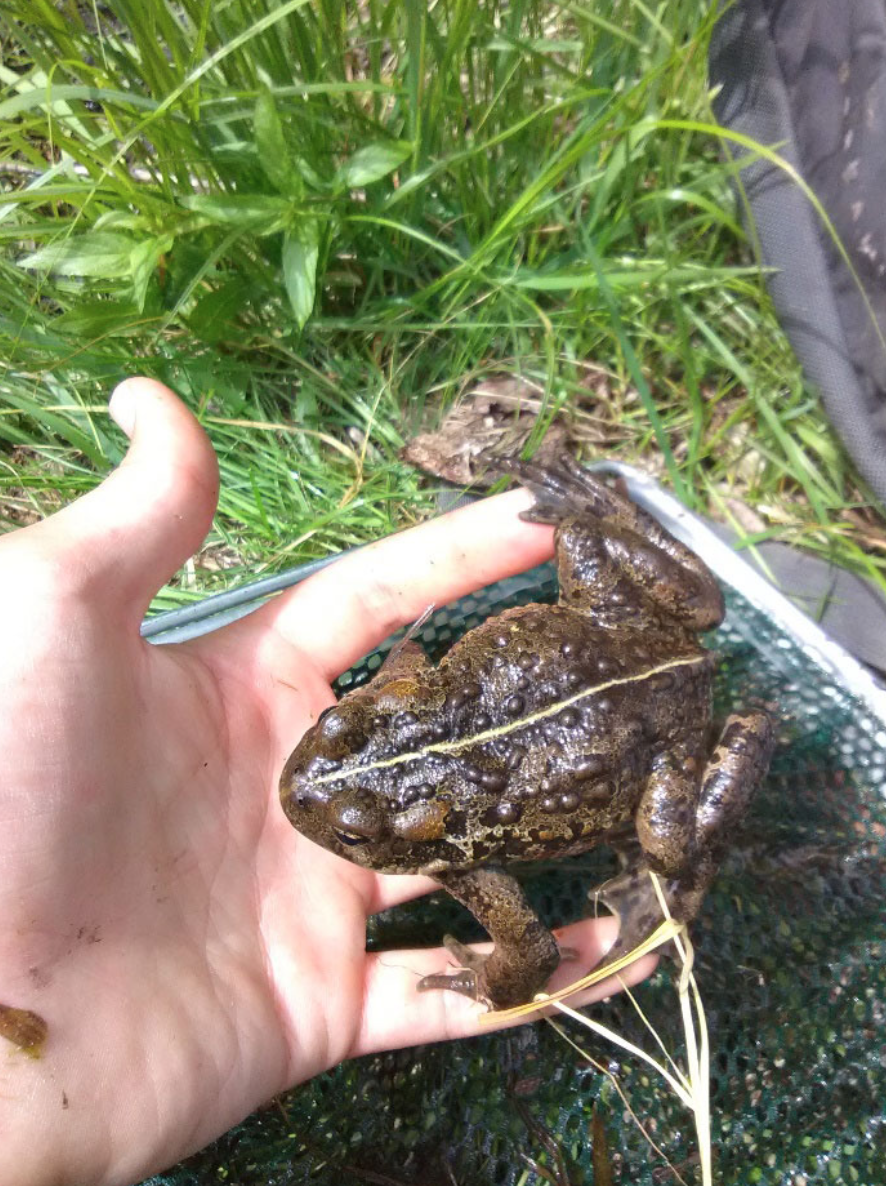With a Stomp and a Leap
SVC Partners with Montana Land Reliance to Advance Long-Term Amphibian Monitoring
By Rob Rich
August 19, 2018
With a sound that registered somewhere between plunging a toilet and a breeze through aspens, Matt Bell stepped his sandaled foot into the pond’s shallow edge. Squish, squish-squish. “This is the Frog Stomp,” he deadpanned, as if the practice had been widely endorsed by amphibian authorities beyond the Montana Land Reliance (MLR) where he works. “These guys are camouflaged and hard to see in the shadows, and the idea is to trigger some movement out of them.” Nothing jumped. Only ripples and the hum of mosquitoes, the essence of a pothole pond in the foothills of Mission Mountains. We sloshed ahead, slowly, minimizing our wake, then did the Frog Stomp again. Squish-squish. Squish. “There!” Randy Wilson exclaimed, scooping at the sound of a plop with the instinct of an eight-year old. He raised his net. “Congratulations,” Matt said. “You just caught your first Columbia spotted frog.”
With back arched and legs spring-loaded, this Columbia spotted frog is ready to make the leap back to the safety of his wet home. Columbia spotted frogs lay their eggs in softball-size clusters, and this was the most abundant species Randy encountered this year. (Photo: Randy Wilson)
Though he'd barely changed out of cap and gown from his recent graduation University of Montana’s Wildlife Biology program, Randy was no eight-year-old. And despite the fun of it, our training session to monitor amphibians was not merely child’s play. In a repeat of Matt’s work on an amphibian census of the Swan Valley 15 years ago, Randy went on to survey 157 ponds and wetlands earlier this summer. SVC provided lodging for Randy in Condon while he worked with MLR during the amphibian breeding season, and we were thrilled to learn that he documented new observations of every amphibian species he expected to find. Given the abundant meltwater this spring, Randy also documented some unexpected “incidental” sites, and one of them – not more than ten feet across – had the highest density of long-toed salamanders in the entire survey. After struggling to find them early on, Randy became fond of the salamanders as they hatched from small egg masses clung to vegetation, then grew with his experience throughout June. But Randy’s favorite species was the western toad, a rare quarry for which he documented several new breeding sites.
At the risk of getting peed on – a frequent defense for a handled western toad – Randy snapped this excellent picture, highlighting the warts and diagnostic white stripe bisecting the back. Formerly the most common amphibian of northwest Montana, western toads are now a species of concern in the state and declining across their range in the American West. This decline is despite the fact they can lay over 10,000 eggs, which lace in long, necklace-like strands across shallow water. Each egg can hatch into coal-black tadpole that swarms in clusters of its kin, and those who survive to adulthood ultimately migrate from wetlands (sometimes great distances) to forage and hibernate before returning to breed the next spring. In their initial forays to land, the tiny toadlets can move in mass across roads from July-September, so keep alert for hopping gravel, and give toads a break! (Photo: Randy Wilson)
The Swan Valley has no canaries and no coal mines, but amphibians may be the best indicator of the health of our wetlands, and perhaps the whole of our ecosystem. If that sounds dubious, consider the fact that though wetlands cover a mere on two percent of the Intermountain West, they hold 80 percent of its biodiversity. And, though wetlands cover only one percent of Montana, the Swan is graced with 16 percent of these precious habitats. Traditionally supplied by long-lasting snows channeled on two sides from high peaks, the Swan’s wetlands are the legacy of former glaciers (whose dragged sheets and relict chunks made potholes of this place) and beavers (whose creations slow water that become crucibles of life).
The lives of amphibians – migrating through food webs as herbivore to carnivore, through habitats on water and land – are highly complex and vulnerable. As one mentor of mine says, “their skin is their lungs” – their bodies’ surface so thin and porous that they literally breathe through it, inhaling the finest of changes in the temperature, pollutants, and chemistry of water. Because we have collectively failed to notice and nuance their habitat sensitivities, amphibians have become the most internationally imperiled class of animals due to habitat loss, invasive species, disease, pollution, and more. With habitat that is a bit more contiguous, the management implications for these concerns are a bit simpler on public land, but the vast range of attitudes and land use practices on private land can make amphibian conservation more of a challenge.
That’s why SVC is thankful to partner with MLR, who works with private landowners to create conservation easements that prevent development and protect agricultural lands, fish and wildlife habitat, and open space. Each of their easements is a legal record that stays with the land in perpetuity, and it can be tailored to include the qualities that the landowner wishes most to conserve. Randy’s survey this summer was so important because, as a complement to the data that Matt collected in 2003 and 2004, it contributes to knowledge grounded in long-term monitoring that will help landowners to value and prioritize amphibians in their stewardship.
As Eagle Scout and fresh college graduate, Randy was eager to put his studies and outdoor enthusiasms to the test in the Swan. In honing new strengths in navigation, proving his competence as a field scientist, and responding wisely to a grizzly’s charge, there’s no question Randy is destined to become a conservation leader. He’s currently off to a new internship with American Prairie Reserve, and all of us – from toads to bison to people – will benefit from working with this fine young man. (Photo: Randy Wilson)
If you have questions about conserving amphibians and their habitats on your land, please feel free to reach out to me at SVC (rob@svconnections.org) or Matt at MLR (matt@mtlandreliance.org). We’ve got a lot to learn about our local amphibians, and we need your help to ensure they live on!




